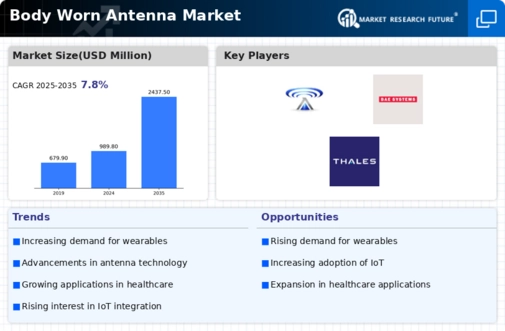Top Industry Leaders in the Body Worn Antenna Market

Key Players
Alaris Antennas (South Africa)
Antenna Products (US)
BAE Systems (US)
Cobham plc (UK)
Harris Corporation (US)
Northrop Grumman Corporation (US)
Panorama Antennas Ltd (UK)
ROHDE&SCHWARZ (Germany)
Southwest antennas (US)
Thales Group (France)
Strategies Adopted
Industry news within the Body Worn Antenna market reflects ongoing trends, regulatory changes, and technological advancements driving the sector forward. News related to successful antenna deployments, partnerships for product development, and advancements in materials and manufacturing processes showcase efforts to enhance antenna performance and reliability. Moreover, developments in Body Worn Antenna applications, such as the integration of antennas into smart clothing for health monitoring and first responder applications, are frequently covered in industry news, reflecting the industry's commitment to innovation and addressing evolving customer needs.
Current investment trends in the Body Worn Antenna industry underscore a focus on research and development, manufacturing capabilities, and strategic collaborations. Key players are directing investments towards improving antenna performance, exploring new materials and manufacturing techniques, and collaborating with end-users for system integration. Investments in digital infrastructure, compliance with wireless communication standards, and the development of ruggedized antenna solutions are prevalent, reflecting the industry's adaptation to the growing demand for reliable and high-performance Body Worn Antennas. Additionally, strategic investments in acquisitions and partnerships aim to strengthen market presence and enhance the overall capabilities of Body Worn Antenna providers.
Emerging Companies
As the demand for Body Worn Antenna solutions continues to grow, new and emerging companies are entering the market, contributing to innovation and product diversification. Start-ups and specialized firms such as Fractus Antennas, Inventus Power, Yageo Corporation, Molex LLC, and Linx Technologies are gaining recognition by providing tailored Body Worn Antenna solutions and addressing specific requirements, such as miniaturization, high data rate transmission, and integration with wearable devices. These companies often leverage research and development capabilities to introduce cutting-edge technologies, including metamaterials for antenna size reduction, phased array systems for beamforming, and multi-band antennas for frequency agility. The industry is witnessing a trend towards the development of flexible and conformal Body Worn Antennas that can be seamlessly integrated into clothing and equipment.
The overall competitive scenario in the Body Worn Antenna market is characterized by established brands and dynamic newcomers, each navigating the industry with distinct strategies. Market share analysis considers factors such as antenna performance, versatility, and compatibility with wearable devices and communication systems. The industry's responsiveness to technological advancements, regulatory requirements, and customer preferences further shapes competitiveness. As wireless communication continues to evolve and expand into new applications, the Body Worn Antenna market is poised for continued growth. Companies in this sector are striving to balance innovation, quality, and affordability to maintain a competitive edge in a dynamic and rapidly evolving telecommunications landscape.
Recent News
Cobham (UK):
Focus on Interoperability: Cobham prioritizes developing body worn antennas compatible with various communication systems and equipment from different manufacturers, ensuring seamless connectivity for diverse operational needs.
New Antenna Designs for Emerging Technologies: Cobham invests in research and development for antennas supporting new communication technologies like 5G and CBRS, enabling future-proof solutions for enhanced data capacity and network reliability.
Thales Group (France):
Emphasis on Miniaturization and Wearability: Thales focuses on designing compact and lightweight body worn antennas, prioritizing user comfort and minimizing interference with equipment or movement.
Collaboration with First Responders: Thales actively collaborates with fire departments, police forces, and other first responders to understand their specific communication needs and tailor antenna solutions accordingly.
Panorama Antennas (USA):
Focus on Multi-Band Antennas: Panorama Antennas specializes in multi-band antennas capable of supporting multiple communication frequencies on a single platform, simplifying equipment and reducing complexity for users.
Customization and Ruggedization: Panorama offers custom antenna design services and ruggedized construction for their products, ensuring durability and reliable performance in harsh environments.
Rohde & Schwarz (Germany):
Focus on Secure Communication: Rohde & Schwarz prioritizes security features in their body worn antennas, offering encryption capabilities and advanced jamming protection for secure communication in sensitive situations.
Network Management and Optimization: Rohde & Schwarz offers antenna management software for optimizing network performance and ensuring signal quality for large deployments of body worn antennas.
Harris Corporation (USA):
Focus on Mission-Critical Applications: Harris targets its body worn antenna solutions for mission-critical applications like military operations and emergency response, prioritizing reliability and resilience in challenging situations.
Interoperability with Military Systems: Harris ensures compatibility of their antennas with existing military communication systems and protocols, facilitating seamless integration into established workflows.


